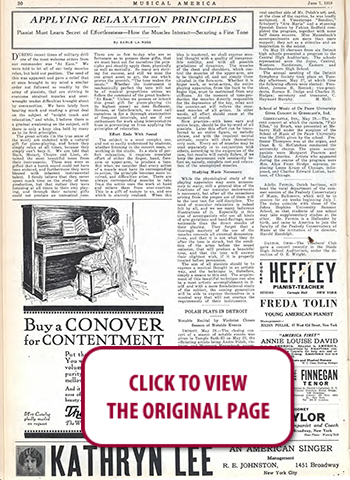 100 YEARS AGO IN MUSICAL AMERICA (283)
100 YEARS AGO IN MUSICAL AMERICA (283)
June 7, 1919
Page 30
APPLYING RELAXATION PRINCIPLES
Pianist Must Learn Secret of Effortlessness—How the Muscles Interact—Securing a Fine Tone
By EARLE LA ROSS
DURING recent times of military drill one of the most welcome orders from our commander was “At Ease.” We were told to let all of our body muscles relax, but hold our position. The need of this was apparent and gave a relief that at once brought to my mind a similar order not followed so readily by the army of pianists, that are striving to overcome strained muscles and overwrought tendon difficulties brought about by overexertion. We have lately been hearing much and reading a great deal on the subject of “weight touch and relaxation,” and while, I believe there is .a gradual awakening on the subject, still there is only a hazy idea held by many as to its first principles.
The great artists (in the true sense of the word) are endowed with a natural gift for piano-playing, and hence they simply relax at all times, because they simply can’t help it. We are told that Bach, Mozart, Chopin and Liszt, obtained the most beautiful tones from their instruments. These men were so gifted that a harsh sound could not have been endured, and furthermore they were blessed with inherent instrumental talent. I firmly believe that they never spent much time on the study of tone-production, but that rather they were listening at all times to their own playing, and through their natural gifts could not produce an unmusical tone.
There are so few to-day who are so fortunate as to possess these gifts, that we must hunt out for ourselves the principles and steadily apply them, physically as well as mentally. So many are striving for success, and still we miss the one great asset to art, the one which proves the proverb, “The tone makes the music.” Whether the instrument is mechanically perfect the tone will not be of musical proportions unless we follow the command of the great leaders: “At Ease.” Unless we possess or inherit this great gift for piano-playing (in its highest sense) as does Hofmann, Novaes, or Gabrilowitch, we must call ourselves in for a thorough examination at frequent intervals, and see if our enthusiasm for work along interpretative lines is preventing us from applying the principles of relaxation.
Effort Ends With Sound
The subject is a most complex one, and not so easily understood by students, whether listening in the concert room, or working in the studio. In a state of perfect relaxation, it requires muscular effort of either the finger, hand, forearm or upper-arm, to produce a tone. But when we consider that every action of a muscle must have its corresponding in-action, the principle becomes more involved, and difficulties arise. There are always corresponding muscles to take from the active ones the work at hand and relieve them from over-exertion. This is a gift of nature to us, and one which is scarcely realized. When this idea is mastered, we shall express musical thought with a quality of inexpressible nobility, and with all possible gradations of dynamics. The muscles of the chest and shoulders, which control the muscles of the upper-arm, are to be thought of, and not simply those situated in the fore-arm. Whether it is finger work, or wrist-action, the entire playing apparatus, from the back to the finger tips, must be restrained from any stiffness. At the moment of tone-production the muscles directly responsible for the depression of the key, relax and the counter-set will relieve the once-used muscles of all action. In other words, all effort should cease at the moment of sound.
Slow practice—with keen ears and active brain, should be the by-word of all pianists. Later this effort can be transferred to an entire figure, or melodic phrase, and with the required mental attitude, results will show themselves very soon. Every set of muscles may be used separately or in conjunction with others, according to the exigencies of the case, but results will surely follow, if we keep the paramount rule constantly before us, namely, complete rest and relaxation of the unemployed muscles.
Studying Music Necessary
While the physiological study of the playing apparatus may seem unnecessary to many, still a general idea of the functions of our muscular endowments is necessary, but after all the sensations arising from the proper use of them will be the best test for self-discipline. The need of muscular relaxation is indeed felt by all, and we see many ludicrous illustrations of it. Especially is this true of accompanists who use all kinds of arm-gyrations and hand-flarings, more noticeable than the direct results of their playing. They forget that a thorough mastery of the use of the muscles conceals all external demonstrations, and that it is not what they do after the tone is struck, but the condition of the arms before the sound emission, that will produce a beautiful tone, and that the tone will answer their slightest wish, if it is properly treated before percussion.
The aim of all pianists should be to express a musical thought in an artistic way, and the technique is, therefore, simply a means to this end. The acquirement of this beautiful technique can also be a most artistic accomplishment in itself, and with a more foundational study of the subject, the coming generation will be able to express themselves in a musical way that will not overtax the requirements of their instruments.




 RENT A PHOTO
RENT A PHOTO





